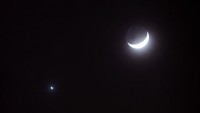Venus And Jupiter Are Having A Celestial Date Tonight
| KJ Belonio | | Jun 30, 2015 07:07 AM EDT |
(Photo : You Tube/Nemesis Maturity) Two planets are set to make a dramatic and spectacular sight on June 30. The second and the fifth planets farthest from the sun, Venus and Jupiter, are going to converge at the end of the month.
In the western twilight sky, Venus and Jupiter will have a spectacular celestial date on the nights of June 30 and July 1, The Hindu has learned. These two of the brightest star-like objects in the sky have been drawing closer together throughout June and will spend eight evenings within 2 degrees from each other from June 27 through July 4.
Like Us on Facebook
On Tuesday evening, the finest conjunction will be upon us. For the past several months, Jupiter and Venus have been slowly approaching each other like two lovers in a long courtship. The second and the fifth planets farthest from the sun will finally reach their minimum separation of just over a quarter degrees. So, what makes this conjunction very special?
Two celestial bodies are said to be in conjunction when they have the same right ascension or longitude and line up one atop the other. According to Universe Today, conjunctions are fairly common with a dozen or more planet-to-planet events a year while 7 or 8 moon-to-planet matchups a month. And since it is so fascinating to see even just a single bright planet, the conjunction between Venus and Jupiter is indeed very special.
All eight planets in the solar system travel the same celestial highway around the sky called the ecliptic. However, they orbit at different rates depending upon their distance from the Sun. Far-off planets like Saturn and Neptune travel more gradually than closer-in planets like Mercury and Mars. Over time, they lap one another in the sky, pairing up for a week or so. But after these brief rendezvous, the planets part ways and move on to future engagements.
Meanwhile, the best opportunity to see the Venus-Jupiter conjunction this week is to look westward and high in the evening sky beginning a half hour after sunset. Though Venus is only a tenth of Jupiter's size, the planet will appear much brighter because Venus is enshrouded with highly reflective clouds of carbon dioxide and is about 56 million miles away. Jupiter, on the other hand, is much more distant at 550 million miles, Oregon Live revealed.
After July 1, however, Venus and Jupiter will appear to rapidly set apart and sink closer to the horizon. And by the end of July, both planets will be lost in the glare of the sunset. Fortunately, the planets will reappear in late August as bright morning stars visible before dawn.
Venus and Jupiter will also offer one last glimpse at dusk in mid-July. And for the majestic dénouement, the planets will be joined by the thin crescent moon on July 18.
Tagsvenus, Jupiter, Celestial Bodies, Science
©2015 Chinatopix All rights reserved. Do not reproduce without permission
EDITOR'S PICKS
-

Did the Trump administration just announce plans for a trade war with ‘hostile’ China and Russia?
-

US Senate passes Taiwan travel bill slammed by China
-

As Yan Sihong’s family grieves, here are other Chinese students who went missing abroad. Some have never been found
-

Beijing blasts Western critics who ‘smear China’ with the term sharp power
-

China Envoy Seeks to Defuse Tensions With U.S. as a Trade War Brews
-

Singapore's Deputy PM Provides Bitcoin Vote of Confidence Amid China's Blanket Bans
-

China warns investors over risks in overseas virtual currency trading
-

Chinese government most trustworthy: survey
-

Kashima Antlers On Course For Back-To-Back Titles
MOST POPULAR
LATEST NEWS
Zhou Yongkang: China's Former Security Chief Sentenced to Life in Prison

China's former Chief of the Ministry of Public Security, Zhou Yongkang, has been given a life sentence after he was found guilty of abusing his office, bribery and deliberately ... Full Article
TRENDING STORY

China Pork Prices Expected to Stabilize As The Supplies Recover

Elephone P9000 Smartphone is now on Sale on Amazon India

There's a Big Chance Cliffhangers Won't Still Be Resolved When Grey's Anatomy Season 13 Returns

Supreme Court Ruled on Samsung vs Apple Dispute for Patent Infringement

Microsoft Surface Pro 5 Rumors and Release Date: What is the Latest?











